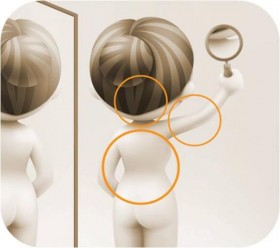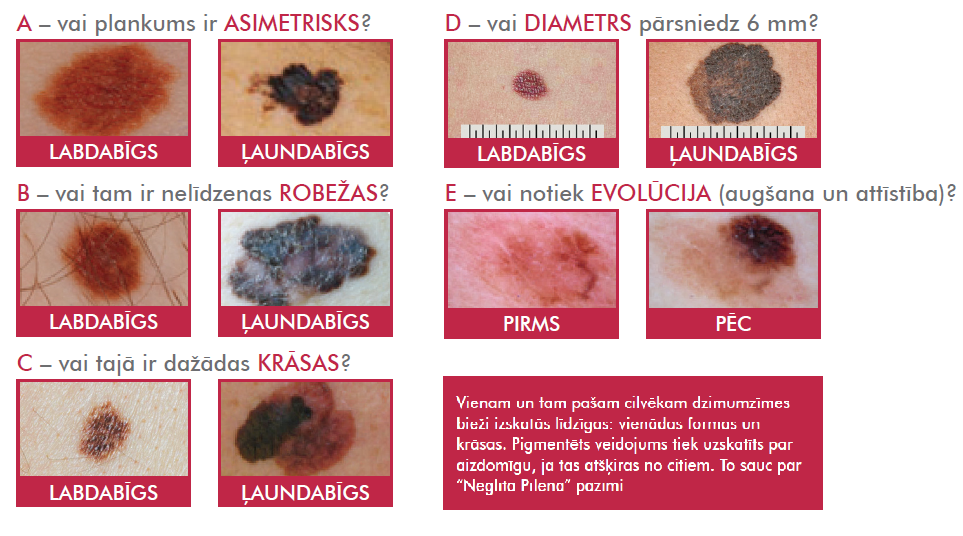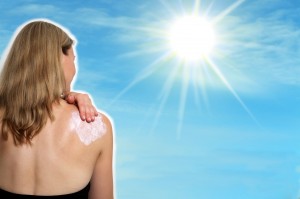
Who is at risk?
Skin cancer is most common in people over the age of 50 and in people exposed to prolonged or severe sun exposure. But it can also affect younger people.
 People at high risk:
People at high risk:
• Light skin or prone to sunburn
• Childhood sunburn
• Spending a lot of time or still spending time in the sun (e.g. due to work or hobby)
• Periodic sun exposure (eg on vacation)
• Sunbathing or sunbathing
• Over 50 birthmarks
• A family member has had skin cancer
• Older than 50 years old
• Patients after organ transplantation
Note: Skin cancer can develop even if you are not at high risk.
It is always better to be safe than to repent. If in doubt, consult your doctor or dermatologist.
 How and what to check?
How and what to check?
Create a habit of checking your skin once a month. Not all suspicious spots appear in visible places or in direct sunlight.
So check your whole body – both front and back, preferably in front of the mirror showing the whole body.
 |
1.Test your face, including your nose, lips, mouth and skin behind your ears. |
 |
2. Check the scalp by using a comb. For men: If there is a naked head, carefully inspect the entire head surface. |
 |
3.Check your hands, tops and wrists, and your fingertips. |
 |
4. Next check your neck, chest and upper body. For Women: Check your skin between and below your chest. |
 |
5. Bend your arm in the elbow to test your forearms and armpits. |
 |
6. Use a small mirror to check the back of the neck and back. |
 |
7. Check the back of the buttocks and legs. At the end, check the fingers and the bottom of the foot. |
 |
8. Finally, check the bottom of your foot and between your toes. |
What to look for?
Search for changes:
Everyone has spots on the skin. They are a sign of normal skin aging. However, sometimes they can be a warning about something dangerous.
Signs of skin cancer
Pay attention to skin spots that:
• Change in size, color and / or shape
• Look different than others
• are asymmetric
• Touching is rough or scaly, sometimes skin lesions can be felt before they become visible
• Are available in different colors (mottled)
• Are itchy
• Bleed or release liquids
• Have a pearl shine
• Look like a wound, but doesn’t heal
Look for signs of skin cancer.
If you notice two or more of these signs, consult your dermatologist.
4 Main types of skin oncological diseases
1. BODY CELL CARCINOMA
This is the most common but least dangerous form of skin cancer. Typically, it is a raised skin color with a glossy pearl edge or as a non-healing wound, or as a skin elevation with a small scab, which slowly increases with time. In very rare cases, this type of skin cancer can spread to other parts of the body. If the basal cell carcinoma is not treated for a long time, it can excite and spread to deeper tissues.
2. ACTINIC KERATOSIS
These reddish-brown, scaly, and rough skin spots are most common in people in middle-aged and elderly or exposed areas such as the face, neck, ears, palms of the hands, and the scalp (men with baldness). These lesions appear regularly and indicate very strong sun exposure. This is a pre-cancerous condition that can develop into squamous cell carcinoma in 10 to 15% of cases.
Actinic keratosis on the naked head often occurs as a result of chronic sun damage.
3. FLAT CELL CARCINOMA
This is the second most common form of skin cancer. Typically, it occurs in areas exposed to frequent exposure to sunlight, such as the face and head. It manifests itself as a shrimp skin lift, possibly fast-growing, so it can whip and sulot. Flat cell carcinoma can spread rapidly, especially if it is on the lips, ears or fingers, or when the patient is immunosuppressed (with depressed immune system). Surgical treatment is required.
4. MELANOMA
This is the most rare but most dangerous form of skin cancer, as melanoma can also spread to the internal organs. Compared to basal cell carcinoma and squamous cell carcinoma, it is also found in younger age. It consists of dark pigmented skin patches that appear irregular borders and patchy coloring within weeks or months. It can also take the form of a rapidly growing pink or red skin elevation with pigmentation. Immediate treatment is required.
Signs of melanoma
For the same person, birthmarks often look similar: identical shapes and colors. A pigmented formation is considered suspicious if it differs from others. It is called the “ugly duckling” sign.
Remember the signs of melanoma ABCDE: Early detection is a prerequisite for successful treatment.
A) Is the damage asymmetric ?
B) Does it have uneven sides ?
C) Does it change colors ?
D) Does its diameter exceed 6 mm?
E) Has its size, shape or behavior changed over time?
 How to prevent skin cancer?
How to prevent skin cancer?
• Increase protection for children (regular use of sunscreen with high SPF (30 to 50), shirt and hat).
• Apply sunscreen every two hours.
• Don’t sunbathe.
• When the sun is most powerful (from 11 to 16 days), you are not in the sun, but stay in the shade.
• Protects your skin and eyes (hat, shirt, sunglasses).
• Prevent the skin from becoming red in the sun: avoid sunburn!
• Check your skin regularly and visit your doctor or dermatologist if you notice any unusual changes.

Contact your dermatologist to check your skin condition. Era Esthetic Laser Dermatology Clinics doctors consultation You will be provided with a dermatoscopic examination and information on how you can protect yourself from the risk of malignant skin diseases.
 People at high risk:
People at high risk: How and what to check?
How and what to check?




 How to prevent skin cancer?
How to prevent skin cancer?
 Riga
Riga 
